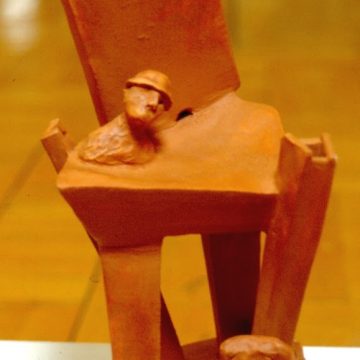Artist at Work
photo collage
The practice of transforming an art gallery or a museum into a site where artists don’t just exhibit their work but also create it isn’t new, but it isn’t usual. Galleries and museums are generally reserved for finished work; they operate backwards from the surface of the image to speculate about what is under it. Museums and galleries which exhibit the work of deceased artists have no choice but to proceed in this manner, investing much manpower, effort and money to gain insight into the artists’ processes because they know that without this knowledge, the work cannot be fully understood or preserved. The audience gets at most third-hand knowledge of their findings.
There are many living artists also exhibiting in galleries and even in museums, possibilities for direct contact and observation abound. Since the artist’s process is an integral part of the finished work – there would be no finished image without it – first-hand knowledge of the artist’s how and why would greatly deepen the audience’s relationship to the work. Courses or workshops in art techniques where the viewer becomes the creator are not enough to give the public this more intimate understanding because each artist handles creativity, technique and concept differently. Problem is, artistic processes, sometimes (especially) the artists themselves, aren’t as easily packaged or as neatly displayed as their work. They might even contradict or belie carefully constructed didactic materials or curatorial statements.
As for said living artists, creation is a private act requiring uninterrupted focus and uninhibited self-exposure, and demanding great energy. Awareness of an audience at this time, especially an ‘inexpert’ one, is usually dangerous, particularly if it happens in the artist’s studio, the one place where the artist can seek solitude, expect privacy and be as improvisational, messy, bad tempered and unruly as the inspiration demands. In the studio, even the presence of other artists can be an irritant or distraction.
Yet, despite these drawbacks, there is a great service the gallery or museum can play in creating opportunities for audiences to witness at least some aspects of the creation process. Unlike the studio, it is universally understood that the gallery is not a private space. Since it is designed as a place for viewing, the artists themselves, ‘veut, veut-pas’ (want or not) become part of that which is viewed, their work being a kind of proxy. Artists who come to create in it can have a say in how they are viewed, even if, without reverting to ‘performance’, they have to adjust their expectation of privacy. The audience’s perception becomes a part of the creation process itself, another element which the artist can conquer to explore gesture and concept development. How does/should being observed actually affect the decision-making process? (the quantum mechanics question of art making). How can one be both a focused creator and invulnerable to observation during the process, and work without artifice or self-consciousness?
Through different in-gallery creation projects, I seek to create opportunities for two types of in-process audience observation: artists share the gallery space to create individual works that must nevertheless respond to that of the others; the public is invited at intervals to view the work’s progress. In both cases, the audience understands its privileged access and acts accordingly, and the artists accept the presence of the viewers as benign.
I held my first in-gallery creation project in Montreal at Galerie de la Ville in Dollard des Ormeaux in 1998 under the Improvisations title and as part of the Galerie’s Special Events. It, as well as the four other projects I held there in 2001, 2008, 2012, 2013, and a collaborative, off-site creation challenge in 2010, involved in total more than fifty artists. The projects are described in visual detail in the bilingual brochures posted on the gallery’s Brochures box on the web site www.centreartdollard.com..
The next Improvisations project at Galerie de la Ville is scheduled for 2015.







